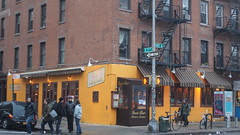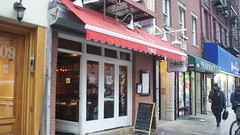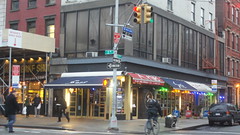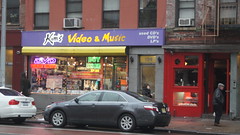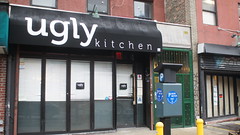In 1986, a New York magazine article coined the term “blintz-krieg” while reviewing over a dozen Polish and Ukrainian coffee shops and restaurants then crowding the neighborhood. In light of Polonia’s recent closing, it seems a fitting time to remember some of those Eastern European haunts.
In 1966, Andy Warhol came upon the ballroom of the Polish National Home in a row of St. Marks Place townhouses when searching for a venue for a nightclub he hoped to create. The Polish National Home had taken over 19-25 St. Marks Place back in the 1920s. In the 1880s, when the area was known as Little Germany, the buildings had housed the Arion Society, a German music club. Warhol took part of the Polish Home’s name (Polski Dom Narodowy) for his club, The Dom, in which he showcased a then unknown band he managed, The Velvet Underground. (Yesterday, The Post reported that the band is suing the Andy Warhol Foundation for the Visual Arts.)
It is still difficult to walk along Avenue A and pass the corner of East Seventh Street without remembering the scent of sauerkraut wafting out of Leshko’s, which graced the corner from 1957 until 2000. The greasy-spoon ambiance served to cloak the home-cooked Slavic delicacies served within, along what was referred to as Pierogi Row (a few doors to the north, Odessa was still thriving). Thick slabs of challah French toast, as well as kasha and onions served with eggs were delivered to the vinyl-clad booths where local old-timers sat beside blue-collar workers and Mohawk-coiffed punks.
Allen Ginsberg had a particular affection for the local Polish and Ukrainian haunts, which he immortalized in photograph and poem. He was a regular at the Kiev, Christine’s, and K.K., where another Polish restaurant, Neptune, now is.
At the ever-crowded Kiev, located on Seventh Street and Second Avenue, one never failed to run into a friend or acquaintance.
Locals wandering up First Avenue miss the sight of lengthy coiled kielbasa and delicately smoked hams which filled the window of Kurowycky Meat Products until it closed in 2007 after 52 years in business. In a Times article, Jerry Kurowycky, the owner of the Ukrainian meat market, lamented the neighborhood’s changing culinary habits.
Polish mainstays which have disappeared from First Avenue include Christine’s and Teresa’s. Regulars grew to depend on a cheery greeting from the heavily accented waitresses who filled endless cups of coffee for those on their way home from a night of parties at the after-hours clubs. You could peer into the kitchen and watch the babushka-clad older women delicately rolling blintzes.
Perhaps all of this has stirred some memory of your favorite haunt, or has at least whet your appetite to head to one of the remaining neighborhood spots for a plate of blintzes or pierogi.




